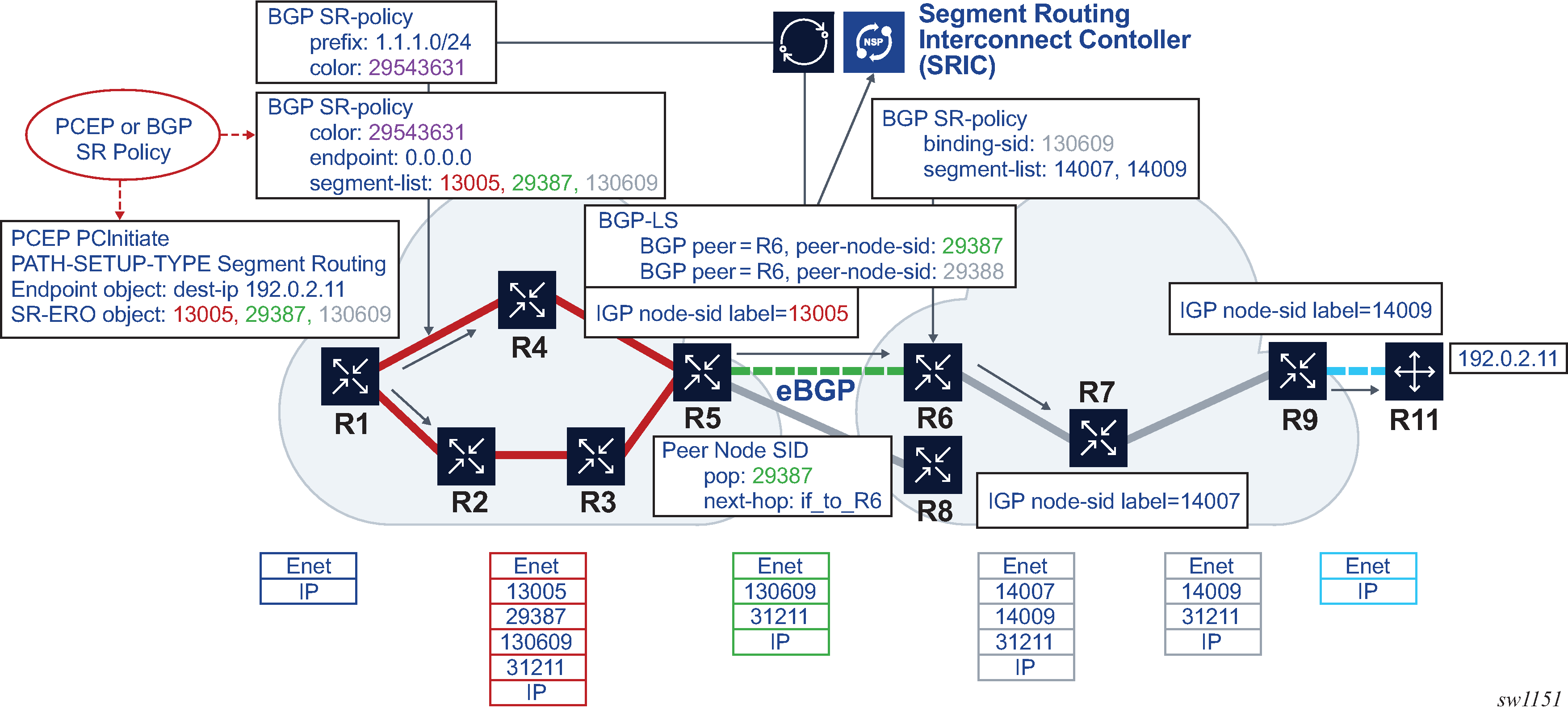BGP Egress Peer Engineering (BGP EPE) extends segment routing (SR) capabilities beyond the AS boundary toward directly attached EBGP peers. Operators can use a central controller to enforce more programmatic control of traffic distribution across these BGP peering links.
An SR SID can be allocated to a BGP peering segment and advertised in BGP Link State (BGP-LS) toward a controller, such as the Nokia NSP. The instantiation of the following BGP peering segments is supported:
-
an eBGP or iBGP peer (peer node SIDs as defined in RFC 8402, Segment Routing Architecture)
-
a link to such a peer (peer adjacency SIDs as defined in RFC 8402, Segment Routing Architecture)
The controller includes the specific SID in the path for an SR-TE LSP or SR policy, which it programs at the head-end LER. EPE enables a head-end router to steer traffic across a downstream peering link to a node, for traffic optimization, resiliency, or load-balancing purposes.
Figure: EPE example use case shows an example use case for BGP EPE.

In this example, there are two IGP domains with eBGP running between R5 and R6, and between R5 and R8. These adjacencies are not visible to R1, which is external to the IGP domain. At R5, separate peer node SIDs are allocated for R6 and R8. The peer node SIDs are advertised to the Nokia NSP in BGP-LS. This allows the NSP to compute a path across either the R5-R6 adjacency or the R5-R8 adjacency by including the appropriate peer node SID in the path. In the preceding use case, the R5-R6 adjacency is preferable. This peer node SID can be included in either the SR-ERO of an SR-TE LSP that is computed by PCEP or the segment list of BGP SR policy that is programmed at R1. Traffic on this LSP or SR policy is, therefore, steered across the required peering.
EPE is supported for BGP neighbors with either eBGP or iBGP sessions. SR peer node SIDs and peer adjacency SIDs are supported. The SID labels are dynamically allocated from the local label space on the node and advertised in BGP-LS using the encoding specified in section 4 of draft-ietf-idr-bgpls-segment-routing-epe-19.
The peering node can behave as both an LSR and an LER for steering traffic toward the peering segment. Both ILM and LTN entries are programmed for peer node SIDs and peer adjacency SIDs, with a label swap to or push of an implicit null label.
-
BGP EPE only supports neighbor nodes that are directly connected to the egress router (for example, not indirectly through tunnels).
-
BGP EPE SIDs cannot be used as the top SIDs on a tunnel originating at the ingress node to the peering segment. Only IS-IS or OSPF SIDs can be used as the transport SID.
ECMP is supported by default if there are multiple peer adjacency SIDs. BGP only allocates peer adjacency SIDs to the ECMP set of next hops toward the peer node. For non-ECMP next hops, only a peer adjacency SID is allocated and it is advertised if all ECMP sets go down.
LSP ping and LSP trace echo requests are supported by including a label representing a peer node SID or peer adjacency SID in a NIL FEC of the target FEC stack. An EPE router can validate and respond to an LSP ping or trace echo request containing this FEC.